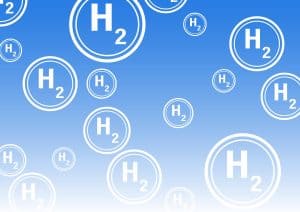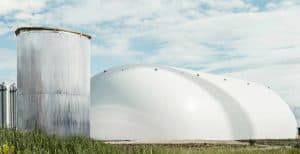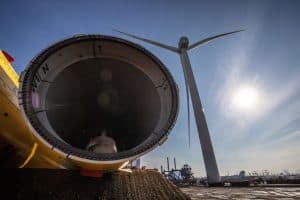
It is a warm spring afternoon at the National Renewable Energy Laboratory (NREL), but the air is buzzing with excitement. As the culmination of two years of work on the Innovating High Throughput Hydrogen Stations (IHS) Project, NREL researchers have successfully demonstrated high-flow-rate hydrogen fueling into a heavy-duty (HD) vehicle system using state-of-the-art capabilities at NREL’s Energy Systems Integration Facility as part of the Advanced Research on Integrated Energy Systems environment.
The achievement contributes to U.S. Department of Energy (DOE) and industry targets for HD fuel cell electric vehicles (FCEVs) and infrastructure, which supports decarbonization advancements in the transportation industry. For well over a decade, NREL has supported cutting-edge research on hydrogen fueling practices for light-duty FCEVs. However, HD trucks and machinery are an undertaking of an entirely different scale.
“To design and build these first-of-its-kind systems, it’s a significant technical accomplishment,” said project leader Shaun Onorato. “This research is instrumental to characterizing hydrogen HD fueling and opens the door for new protocols that shape the future of decarbonized transportation.”
The IHS project—a collaboration with Air Liquide, Honda, Shell, and Toyota—addresses research challenges and technological gaps in developing high-flow-rate hydrogen fueling systems, which include Class 8 semi-trucks, marine, rail, and mining applications. The project is funded in part by DOE’s Hydrogen and Fuel Cell Technologies Office to support DOE’s H2@Scale vision for clean hydrogen across multiple applications and economic sectors. The ultimate goal is to compete with conventional fueling times of diesel vehicles (roughly 10 minutes), which translates to an ambitious hydrogen gas mass flow rate of 10 kg/min average (20 kg/min peak) based on a maximum onboard vehicle storage potential of 100kg hydrogen gas. This rate is roughly 10 times the average mass flow rate currently used for light-duty FCEVs.
On April 26, 2022, the IHS team exceeded this mass flow rate goal, demonstrating an average mass flow rate of 14 kg/min (21 kg/min peak) with a 40.3 kg fill into a bank of 8 hydrogen storage tanks—similar to those used by HD vehicles—in 2.87 minutes. This intermediate milestone will pave the way for the project to meet the ultimate milestone of completing a 60-80kg fill in under 10 minutes with the fast mass flow rates.
Building a bigger hydrogen fuel system
To design an entirely new hydrogen fueling station, researchers looked first to NREL’s Hydrogen Filling Simulation (H2FillS) model. H2FillS is a fast, flexible, and free-to-use thermodynamic model that simulates the hydrogen supply from a hydrogen station to a light-duty FCEV. In 2021, researchers made substantial upgrades to the H2FillS model to align with HD requirements and the IHS project. The latest release optimized the model’s computational speed so that it is now 20x–40x faster than the previous version and added optimization to the pressure ramp rate parameter. In addition, H2FillS now explores the complete hydrogen fueling process to calculate the optimal fueling rate for HD vehicles.
To understand the temperature distribution inside a vehicle’s hydrogen storage tanks (necessary for developing new fueling protocols) researchers conducted 3D computational fluid dynamic modeling using NREL’s supercomputer, Eagle, to pinpoint potential hot spots and optimize mixing characteristics. Over the course of the project, the team completed numerous full and partial fills with computational fluid dynamic modeling to explore aspects like the effect of tank size, injector diameter, and injector angle on gas mixing. Researchers balanced these results alongside experimental testing to continually validate their process and further enhance H2FillS for HD applications.
This integrated process informed the expansion of the Energy Systems Integration Facility’s hydrogen infrastructure to create a new research space for large-scale equipment installations and evaluations. These upgrades included a new isolated concrete pad anchored to the underlying bedrock for suitability with larger research components with vibrational characteristics such as hydrogen compression systems. To ensure compatibility with HD-FCEVs and trucks, researchers incorporated ~300 kg of additional high-pressure hydrogen stationary storage, and designed and built new medium- and high-pressure gas management panels, an HD hydrogen fueling dispenser, a new hydrogen precooling system, and a HD vehicle storage simulation device.
New heavy-duty station capabilities
NREL’s demonstration of high-flow-rate hydrogen fueling opens the door to expanded research into HD hydrogen systems, including fueling protocols (which currently do not exist) and safety, codes, and standards. As the first facility of its kind, NREL’s HD station allows researchers to evaluate hardware devices for HD hydrogen fueling—such as high flow rate nozzles, receptacles, hoses, and breakaways—at a controlled site to ensure the safety and reliability of these devices that currently do not exist on the market. Future collaborations will utilize the new station’s capabilities to assist development of fueling infrastructure for HD-FCEVs.
“We see a bright future for heavy-duty fuel cell vehicles, especially where companies are faced with complex logistics that demand tough duty cycles, long ranges, and fast refueling,” Onorato said. “This milestone signifies new opportunities to develop and validate best-practices for hydrogen fueling to support the adoption of heavy-duty fuel cell trucks.”





